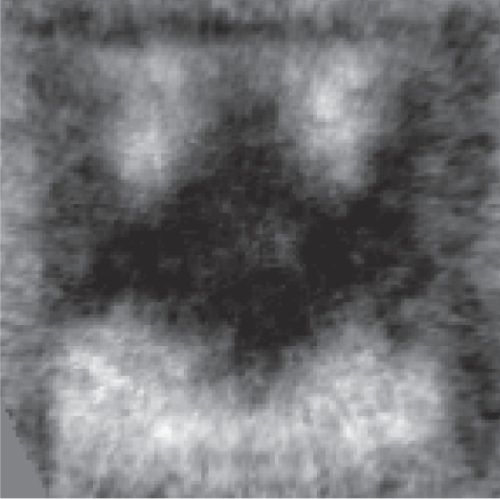Batman lights the way to compact data storage

Researchers at PSI spotted a curious black-and-white magnetic substructure on a five-by-five micrometre square – and were reminded of the stylised Batman logo. The black areas reveal where the magnetisation is pointing downwards, i.e. into the picture; the white ones where it is pointing upwards.
© PSI
Researchers at the Paul Scherrer Institute (PSI) have succeeded in switching tiny, magnetic structures using laser light and tracking the change over time. In the process, a nanometre-sized area bizarrely reminiscent of the Batman logo appeared. The research results could render data storage on hard drives faster, more compact and more efficient.
Excerpt of the PSI-Press release:
The researchers at PSI teamed up with colleagues from the Netherlands, Germany and Japan for the project. Two years ago, the international research team already succeeded in demonstrating that a short, intensive laser pulse can switch micro-magnets hundreds of times faster than a magnetic head. And the laser is lower in energy and thus more cost-effective, too. The trick evidently lies in the fact that the laser light heats up the tiny magnets very quickly and is thus able to convert them into the other state. “Using light for magnetic switching clearly works. But why exactly it does is still the subject of debate in the research community,” explains Frithjof Nolting, the lab head on the PSI study.
“This could be the way to store even more data on even smaller hard drives one day,” says Loïc Le Guyader, who was also involved in the PSI experiments, and is now working at the Helmholtz-Zentrum Berlin.
Please read the complete press release here:
http://www.psi.ch/media/batman-lights-the-way-to-compact-data-storage
Publication: Nanoscale sub-100 picosecond all-optical magnetization switching in GdFeCo microstructures.
L. Le Guyader, M. Savoini, S. El Moussaoui, M. Buzzi, A. Tsukamoto, A. Itoh, A. Kirilyuk, T. Rasing, A.V. Kimel and F. Nolting,
Nature Communications, 12 January 2014,
DOI: 10.1038/ncomms6839
Laura Hennemann /PSI
https://www.helmholtz-berlin.de/pubbin/news_seite?nid=14115;sprache=en
- Copy link
-
Battery research with the HZB X-ray microscope
New cathode materials are being developed to further increase the capacity of lithium batteries. Multilayer lithium-rich transition metal oxides (LRTMOs) offer particularly high energy density. However, their capacity decreases with each charging cycle due to structural and chemical changes. Using X-ray methods at BESSY II, teams from several Chinese research institutions have now investigated these changes for the first time with highest precision: at the unique X-ray microscope, they were able to observe morphological and structural developments on the nanometre scale and also clarify chemical changes.
-
BESSY II: New procedure for better thermoplastics
Bio-based thermoplastics are produced from renewable organic materials and can be recycled after use. Their resilience can be improved by blending bio-based thermoplastics with other thermoplastics. However, the interface between the materials in these blends sometimes requires enhancement to achieve optimal properties. A team from the Eindhoven University of Technology in the Netherlands has now investigated at BESSY II how a new process enables thermoplastic blends with a high interfacial strength to be made from two base materials: Images taken at the new nano station of the IRIS beamline showed that nanocrystalline layers form during the process, which increase material performance.
-
Hydrogen: Breakthrough in alkaline membrane electrolysers
A team from the Technical University of Berlin, HZB, IMTEK (University of Freiburg) and Siemens Energy has developed a highly efficient alkaline membrane electrolyser that approaches the performance of established PEM electrolysers. What makes this achievement remarkable is the use of inexpensive nickel compounds for the anode catalyst, replacing costly and rare iridium. At BESSY II, the team was able to elucidate the catalytic processes in detail using operando measurements, and a theory team (USA, Singapore) provided a consistent molecular description. In Freiburg, prototype cells were built using a new coating process and tested in operation. The results have been published in the prestigious journal Nature Catalysis.
